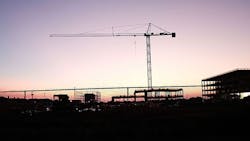AIA’s Baker Sees Solid Year for Nonresidential Construction
Kermit Baker, chief economist for the American Institute of Architects (AIA), Washington, DC, has for years provided some of the best commentary on the construction market’s evolving fortunes. Below are a few highlights of his recent post on what the 2017 construction market may have to offer. To read his entire analysis, go to www.aia.org.
“2016 was a chaotic year for nonresidential building activity. For most serving this market, it turned out to be a successful year — construction spending in this sector rose almost 8%, according to current estimates — even as challenges to the industry were continually emerging. Construction labor remains a major concern. Virtually every segment of the design and construction market is reporting that recruiting and retaining qualified staff is a growing issue. Many workers left the industry during the downturn, and others left the workforce entirely. Rebuilding a competent and productive workforce is a challenge, particularly when the national unemployment rate is below 5%.
“The decade-long decline in interest rates is coming to an end. Long-term rates have been edging up in recent months, and the Federal Reserve Board’s hike in short-term interest rates in December is likely to be matched by another two to three increases this year. Many feel that this current economic cycle is well past its prime, so a recession watch remains. While the imminent threat of a national economic recession seems modest, most analysts have it in the back of their minds and each new economic threat will be viewed in this context.
“However, entering 2017, the industry is looking forward to another couple of years of healthy growth. The economy in general is doing well, with healthy job growth, rising wages, low interest rates, and very strong levels of business and consumer confidence. Construction levels surprised many on the upside this past year, particularly for most commercial categories. According to current estimates, spending on offices increased more than 20% in 2016, hotel spending was up about 25%, and even retail and other commercial facilities saw growth of about 10%. Industrial construction was weak, as expected. Institutional project activity was somewhat disappointing, particularly for healthcare facilities.
“For the coming year, the AIA Consensus Forecast panelists are projecting growth in overall nonresidential building spending of almost 6%, virtually identical to their projection from mid-year 2016. Commercial construction activity is expected to increase in excess of 8% this year, which is slightly above the projection from mid-2016. Industrial construction looks to remain essentially flat at 2016 levels, below the growth expected as of the last forecast. Institutional construction is projected to grow at an almost 6% pace, largely unchanged from last summer’s consensus.
“The Consensus Forecast panel sees the construction cycle continuing to ease moving into 2018. Overall building spending should increase by about 5% that year, with the commercial and industrial sectors growing at a slower rate than the overall building sector. Institutional building activity will pick up some of the slack, growing nearly 6%. Educational facilities are expected to see healthy gains, and even healthcare spending is projected to be fairly strong.”
